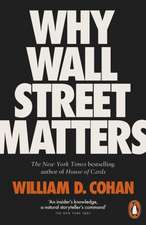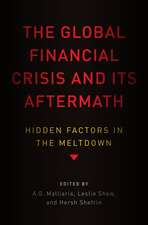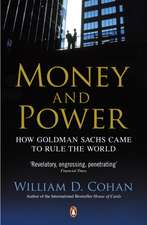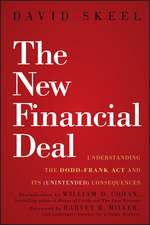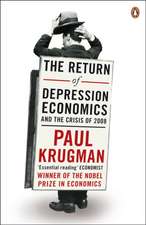House of Cards: How Wall Street's Gamblers Broke Capitalism
Autor William D. Cohanen Limba Engleză Paperback – 3 feb 2010
It was Wall Street's toughest investment bank, taking risks where others feared to tread, run by testosterone-fuelled gamblers who hung a sign saying 'let's make nothing but money' over the trading floor.
Yet in March 2008 the 85-year-old firm Bear Stearns was brought to its knees - and global economic meltdown began. With unprecedented access to the people at the eye of the financial storm, William Cohan tells the outrageous story of how Wall Street's entire house of cards came crashing down.
'A page-turner ... hard to put down, especially thanks to its dishy, often profane, quotes from insiders ... Read it, learn - and weep'
Observer
'A fly-on-the-wall record ... Cohan is a master of this genre. He perfectly captures the raw voice of Wall Street ... like Damon Runyon updated by Martin Scorsese'
Spectator Business
'Action-packed ... gripping'
Sunday Times
'A devastating account of the foul-mouthed, money-grabbing men responsible for Bear Stearns' collapse'
Business Week
William D. Cohanwas an award-winning investigative journalist before embarking on a seventeen-year career as an investment banker on Wall Street. His first book,The Last Tycoons, about Lazard, won the 2007 Financial Times/Goldman Sachs Business Book of the Year Award and was a New York Times bestseller. His second book,House of Cards, also a bestseller, is an account of the last days of Bear Stearns & Co.
| Toate formatele și edițiile | Preț | Express |
|---|---|---|
| Paperback (2) | 114.56 lei 3-5 săpt. | +17.09 lei 6-12 zile |
| Penguin Books – 3 feb 2010 | 114.56 lei 3-5 săpt. | +17.09 lei 6-12 zile |
| Anchor Books – 31 ian 2010 | 137.00 lei 3-5 săpt. |
Preț: 114.56 lei
Nou
Puncte Express: 172
Preț estimativ în valută:
21.92€ • 22.89$ • 18.14£
21.92€ • 22.89$ • 18.14£
Carte disponibilă
Livrare economică 14-28 martie
Livrare express 27 februarie-05 martie pentru 27.08 lei
Preluare comenzi: 021 569.72.76
Specificații
ISBN-13: 9780141039596
ISBN-10: 0141039590
Pagini: 608
Dimensiuni: 129 x 198 x 26 mm
Greutate: 0.42 kg
Editura: Penguin Books
Colecția Penguin
Locul publicării:London, United Kingdom
ISBN-10: 0141039590
Pagini: 608
Dimensiuni: 129 x 198 x 26 mm
Greutate: 0.42 kg
Editura: Penguin Books
Colecția Penguin
Locul publicării:London, United Kingdom
Notă biografică
William
Cohan
is
an
award-winning
journalist
and
veteran
of
Wall
Street.
His
previous
book,The
Last
Tycoons,won
the
2007
Financial
Times/Goldman
Sachs
Business
Book
of
the
Year
Award
and
was
aNew
York
Timesbestseller.
A
regular
on
the
pages
of
theFinancial
TimesandFortune,
the
deal
for
this
book
was
big
news
in
theWall
Street
Journal.
Recenzii
It
is
too
early
to
say
who
will
emerge
as
the
definitive
chroniclers
of
this
crisis,
but
this
book
by
William
Cohan
...
seems
likely
to
end
up
as
one
of
the
key
texts
A riveting, blow-by-blow account
Read it, learn and weep
First drafts of history don't get much better than this
A fly-on-the-wall record ... Cohan is a master of this genre. He perfectly captures the raw voice of Wall Street ... like Damon Runyon updated by Martin Scorsese
A riveting, blow-by-blow account
Read it, learn and weep
First drafts of history don't get much better than this
A fly-on-the-wall record ... Cohan is a master of this genre. He perfectly captures the raw voice of Wall Street ... like Damon Runyon updated by Martin Scorsese
Extras
The first murmurings of impending doom for the financial world originated 2,500 miles from Wall Street in an unassuming office suite just north of Orlando, Florida. There, hard by the train tracks, Bennet Sedacca announced to the world at 10:15 on the morning of March 5, 2008, that venerable Bear Stearns & Co., the nation's fifth--largest investment bank, was in trouble, big trouble. "Yep," Sedacca wrote on the Minyanville Web site, which is dedicated to helping investors comprehend the financial world. "The great credit unwind is upon us. Credit default swaps on all brokers, particularly Lehman and Bear Stearns, are blowing out, big time."
Sedacca, the forty--eight--year--old president of Atlantic Advisors, a $3.5 billion investment management company and hedge fund, had been watching his Bloomberg screens on a daily basis as the cost of insuring the short--term obligations–known in Wall Street argot as "credit default swaps"–of both Lehman and Bear Stearns had increased steadily since the summer of 2007 and then more rapidly in February 2008. Now he was calling the end of the credit party that had been raging on Wall Street for six years. "I've been talking about it for years," Sedacca said later. "But I started to notice it that fall. Because if you think about it, if you have all this nuclear waste on your balance sheet, what are you supposed to do? You're supposed to cut your dividends, you're supposed to raise equity, and you're supposed to shrink your balance sheet. And they did just the opposite. They took on more leverage. Lehman went from twenty--five to thirty--five times leveraged in one year. And then they announce a big stock buyback at $65 a share and they sell stock at $38 a share. I mean, they don't know what they're doing. And yet they get rewarded for doing that. It makes me sick."
Sedacca had witnessed firsthand a few blowups in his day. He worked at the investment bank Drexel Burnham Lambert–the former home of junk--bond king Michael Milken–when it was liquidated in 1990 and lost virtually overnight the stock he had in the firm as it plunged from $110 per share to zero (Drexel was a private company but the stock had been valued for internal purposes). "It was enough that it stunned," he explained. "It was more than a twenty--nine--year--old would want to lose." Many of his Drexel colleagues had taken out loans from Citibank to buy the Drexel stock and were left with their bank loans and worthless stock. "I know people with millions and millions of dollars of debt and the stock was at zero," he said. They either paid off the loans or declared personal bankruptcy. "That's what happens when everyone turns off your funding," he added.
He then moved on to Kidder Peabody and watched that 130--year--old firm disintegrate, too. As a result of these experiences and those at other Wall Street firms, he had developed a healthy skepticism of both debt and the ways of Wall Street. Starting in the summer of 2007, he began to feel certain that the mountain of debt building across many sectors of the American economy would not come to a good end. He started betting against credit. "I've watched enough screens long enough to know something was wrong," he said.
The problem at Bear Stearns and Lehman Brothers, Sedacca informed his clients and Minyanville readers, was that both firms had huge inventories on their balance sheets of securities backed by home mortgages. The rate of default on these mortgages, while still small, was growing at the same time that the value of the underlying collateral for the mortgage–people's homes–was falling rapidly. Sedacca could not help noticing that the effects of this double whammy were beginning to show up in other, smaller companies involved in the mortgage industry. He could watch the noose tighten in the credit markets. "Look at what is happening to Thornburg Mortgage," he wrote, referring to the publicly traded home mortgage lender, which specialized in making what were known as "Alt--A" mortgages, those greater than $417,000, to wealthy borrowers. Thornburg had been "overwhelmed" by margin calls from its lenders. "It supposedly only has a 0.44% default rate on its [$24.7 billion] mortgage portfolio that it services but the bonds it owns are getting pounded. Result? Margin call. The worst part is that the company went to sell some bonds to settle the margin calls but couldn't. The ultimate Roach Motel."
That Thornburg, based in Sante Fe, New Mexico, appeared to be hitting the wall was somewhat surprising considering its customers' low default rate and high credit quality. The problem at Thornburg was not that its customers could no longer pay the interest and principal on their mortgages; the problem was that the company could no longer fund its business on a day--to--day basis. Thornburg had a liquidity problem because its lenders no longer liked the collateral–those jumbo mortgages–Thornburg used to obtain financing.
Unlike a bank, which is able to use the cash from its depositors to fund most of its operations, financial institutions such as Thornburg as well as pure investment banks such as Lehman Brothers and Bear Stearns had no depositors' money to use. Instead they funded their operations in a few ways: either by occasionally issuing long--term securities, such as debt or preferred stock, or most often by obtaining short--term, often overnight, borrowings in the unsecured commercial paper market or in the overnight "repo" market, where the borrowings are secured by the various securities and other assets on their balance sheets. These fairly routine borrowings have been repeated day after day for some thirty years and worked splendidly–until there was perceived to be a problem with either the securities or the institutions backing them up, and then the funding evaporated like rain in the Sahara. The dirty little secret of what used to be known as Wall Street securities firms–Goldman Sachs, Morgan Stanley, Merrill Lynch, Lehman Brothers, and Bear Stearns–was that every one of them funded their business in this way to varying degress, and every one of them was always just twenty--four hours away from a funding crisis. The key to day--to--day survival was the skill with which Wall Street executives managed their firms' ongoing reputation in the marketplace.
Thornburg financed its operations very similarly to the way investment banks did. But in mid--February 2008, Thornburg was having a very difficult time managing its perception in the marketplace because its short--term borrowings were backed by the mortgages it held on its balance sheet. Some of these mortgages were prime mortgages, money lent to the lowest--risk borrowers, and some were those Alt--A mortgages, which were marginally riskier than prime mortgages and offered investors higher yields. At Thornburg, 99.56 percent of these mortgages were performing just fine.
But that did not matter. What mattered was that the perception of these mortgage--related assets in the market was deteriorating rapidly. That perception spelled potential doom for firms such as Thornburg, Bear Stearns, and Lehman Brothers, which financed their businesses in the overnight repo market using mortgage--related assets as collateral.
For Thornburg the trouble began on February 14, halfway around the world, when UBS, the largest Swiss bank, reported a fourth--quarter 2007 loss of $11.3 billion after writing off $13.7 billion of investments in U.S. mortgages. Amid this huge write--off, UBS said it had lost $2 billion on Alt--A mortgages and, worse, that it had an additional exposure of $26.6 billion to them. In a letter to shareholders before he lost his job on April 1, Marcel Ospel, UBS's longtime chairman, wrote that the year 2007 had been "one of the most difficult in our history" because of "the sudden and serious deterioration in the U.S. housing market."
UBS's sneeze meant that Thornburg, among others, caught a major cold. By writing down the value of its Alt--A mortgages, UBS forced other players in the market to begin to revalue the Alt--A mortgages on their books. Since these were the very assets that Thornburg (and Bear Stearns) used as collateral for its short--term borrowings, soon after February 14 the company's creditors made margin calls "in excess of $300 million" on its short--term borrowings. At first, Thornburg used what cash it had to meet the margin calls. But that did not stop the worries of its creditors. "After meeting all of its margin calls as of February 27, 2008, Thornburg Mortgage saw further continued deterioration in the market prices of its high quality, primarily AAA--rated mortgage securities," the company wrote in a March 3 filing with the SEC. This new deterioration of the value of its prime mortgages resulted in new margin calls of $270 million–among them $49 million from Morgan Stanley, $28 million from JPMorgan on February 28, and $54 million from Goldman Sachs.
This time, though, Thornburg was "left with limited available liquidity" to meet the new margin calls or any future margin calls. From December 31, 2007, to March 3, 2008, Thornburg received margin calls totaling $1.777 billion and was able to satisfy only $1.167 billion of them, or about 65 percent–a dismal performance. The balance of $610 million "significantly exceeded its available liquidity," the company announced on March 7. "These events have raised substantial doubt about the Company's ability to continue as a going concern without significant restructuring and the addition of new capital." The company's stock, which had traded for more than $28 per share in May 2007, closed at $4.32 on March 3, 2008, down 51 percent on the day. "The turmoil in the mortgage financing market that began last summer continues to be exacerbated by the mark--to--market accounting rules which are forcing companies to take unrealized write--downs on assets they have no intention of selling," explained Larry Goldstone, Thornburg's CEO. By March 10, Thornburg's stock was trading at 69¢ per share.
Goldstone's explanation of what was happening at his company was merely a heavily lawyered version of what Sedacca referred to as the "ultimate Roach Motel." A vicious cycle of downward pressure on the value of mortgage securities, which had begun at least a year earlier, was reaching a crescendo and affecting the entire asset class, not just the most junior and riskiest mortgages–so--called subprime mortgages–but also the more secure, performing mortgages. The very word "mortgage" was now a synonym for "toxic waste," or, as one wag wrote, "Financial Ebola."
To be sure, other firms were having serious mortgage--related problems, too. "I realized the market in general was far worse than I had imagined," Goldstone told the Washington Post in December 2008. "If UBS had that much, what about Goldman? What about Citi? What about everyone else?" For instance, there was Peloton Partners, a high--flying $1.8 billion hedge fund started in June 2005 by Ron Beller, a Goldman Sachs alumnus. Beller had become well known in financial circles a few years earlier when his secretary at Goldman Sachs stole £4.3 million from him and his partner, Scott Mead, without them realizing it. Before the secretary was convicted, Beller told the jury that he suspected something was amiss when he noticed his bank account was "one or two million light." In 2007, Peloton's asset--backed securities fund returned 87 percent to investors and was named the best fixed--income fund of the year by EuroHedge magazine. But the fund closed in February 2008 after its investments in Alt--A mortgages fell precipitously in the wake of the UBS announcement about its write--downs on February 14–the same announcement that caused Thornburg's problems. Like Thornburg, Peloton faced repeated margin calls from its Wall Street lenders, but unlike Thornburg, Peloton ran out of cash to meet those calls before a rescue plan could be implemented. Beller lost $60 million personally.
Beller's problems had a viral effect on Wall Street. His fund's collapse had the misfortune of occurring on Leap Day, February 29. In another year, the fund would have collapsed on March 1, the beginning of the second quarter. Instead, the collapse came at the end of the first quarter. The new valuation in the market of the securities Peloton owned meant that Wall Street firms such as Bear Stearns had to take into consideration these new marks for their own like securities and reflect those marks in their first--quarter numbers. Since Bear was hoping to show the market that it would have a profit during the first quarter of 2008, the Peloton collapse caused the firm to reevaluate just how profitable it was.
"February 29 was the day Peloton blew up," explained Paul Friedman, a Bear senior managing director and the chief operating officer of the fixed--income division, "and so you had a huge liquidation, us and others, of really high--quality stuff that went at really distressed prices. There were a lot of rumors of that being on dealers' balance sheets, that they couldn't sell it, and we were for once the first out and we got rid of all of it. So you've now got a really serious amount of high--quality paper, and reasonably high--quality counterparties–the whole Peloton thing. This was fund of the year in 2007. Ten weeks later, you're out of business. You've now got a data point. Everybody, at least at our firm and I think at the other firms, is looking on February 29, 'Okay, where are we going to mark our stuff?' because this is now a liquidation. You mark to where you blew out Peloton, which is going to be huge losses, where you couldn't even blow them out the following week. It was sort of the beginning of the end."
Born in Schenectady, New York, Friedman graduated from Colgate University in 1977 with a degree in economics. He then headed off to one of the Big Eight accounting firms, as they were then known, and ended up auditing Drexel Burnham, the last major Wall Street firm to blow up before Bear Stearns. He figured he knew something about Wall Street as a result and applied for the wrong job–something to do with mortgage--backed securities, which he knew nothing about– at Bear Stearns in March 1981. By serendipity, as he was leaving his botched interview, he heard about another job in the operations department and accepted it on the spot. He did that for a while but disliked being in the back office. One day he told his boss that he hated his job. "About an hour later, I was interviewing for a job on the trading desk," he said, "and then moved to being a trading assistant, and then ultimately to a trader on the mortgage desk in the very early days of mortgage--backed securities. Did that for a couple of years, and was a highly, highly mediocre trader." Soon he was the assistant to the guy running the fixed--income department, a job he held for the next twenty years even as the person who ran the department changed often during that time period.
Another clear sign of trouble, along with the margin--call messes at Thornburg and at Peloton, were margin calls being made in Amsterdam against a seven--month--old publicly traded $22 billion hedge fund controlled by the Carlyle Group, the Washington--based investment firm with $81 billion under management run by David Rubinstein. Carlyle has been the home from time to time of many very well--connected politicos, including George H. W. Bush, James Baker, and Olivier Sarkozy, the half--brother of the French president. Rubinstein had very carefully managed the firm's reputation for years with considerable success. Despite its obvious political ties, Carlyle had become one of the most admired private equity firms on Wall Street. "Our mission is to be the premier global private equity firm, leveraging the insight of Carlyle' s team of investment professionals to generate extraordinary returns across a range of investment choices, while maintaining our good name and the good name of our investors," the firm proclaimed. On March 5, the global credit crisis began to consume a piece of Carlyle's "good name" when a fund known as the Carlyle Capital Corporation, listed on the Amsterdam exchange and 15 percent owned by the Carlyle Group, ran into serious trouble because it was heavily invested in residential mortgage--backed securities that were increasingly difficult to value.
In the week between February 28 and March 5, the hedge fund had received margin calls from lenders requiring the fund to post an additional $60 million of collateral. The fund met these margin calls. But on March 5, seven of its thirteen funding counterparties demanded another $37 million of collateral. Carlyle Capital met the demands of three of the seven counterparties but not those of the other four, which led one to send a default notice.
Also on March 6, Tim Geithner, the ninth president and CEO of the Federal Reserve Bank of New York, gave a speech at the Council on Foreign Relations, on Park Avenue, about the unfolding financial crisis. Geithner had served three presidents and five Treasury secretaries, culminating in his appointment as undersecretary for international affairs for Treasury secretaries Lawrence Summers and Robert Rubin. In front of this distinguished audience, Geithner expounded on the origins of the immediate financial crisis in particularly clear language. He explained how a number of unusual factors had come together to undermine the country's economic foundation: the irresponsible availability of credit to the less--than--creditworthy, allowing them to buy homes, cars, and other goods and services they could not afford but thought they needed; a historic and ongoing increase in real--estate values; a "rapid innovation" on Wall Street that made credit risk easier to manufacture, to trade, and, in theory, to hedge. He said these insurance policies–the dreaded credit default swaps–gave investors the appearance of having hedged their bets. "These instruments allowed investors to buy insurance or protection against a broader range of individual credit risks, such as the default by a homeowner or a company," he said. But "as underwriting standards deteriorated over this period, this exposure grew." Investors did not fully appreciate that their risks were not hedged because they continued to predict forward into the future a market awash in liquidity and relative stability. "That confidence in a more stable future led to greater leverage and a larger exposure to the risk of a less benign world," Geithner said. "The interaction of these forces made the financial system as a whole more vulnerable to a range of different weaknesses."
He said everyone became blinded to the risks being created. "As is often the case during periods of rapid change, more significant concentrations of risk were present than was apparent at the time," he said. "Banks and investment banks sold insurance"–the credit default swaps–"against what seemed like low probability events, but did so at what even at the time seemed like low prices. And on the assets they retained, these same institutions purchased insurance from financial guarantors and other firms that were exposed to the same risks. The crisis exposed a range of weaknesses in risk management practices within financial institutions in the United States and throughout the world." After he finished his talk, Geithner took a few mundane questions from the audience. Then he bolted. "I've got to go," he told the guests, to an outbreak of laughter.
The next day, it became obvious why Geithner had had to leave. Before the market opened, he and his fellow Federal Reserve Board governors announced two unusual steps designed to pump additional capital into the markets "to address heightened liquidity pressures" in short--term funding. The effect of the Fed's actions was to inject $200 billion into the banking system by offering banks and securities firms (there were actually two separate loan programs of $100 million each, one for banks, one for securities firms) one--month loans at low rates and allowing them to pledge mortgage--backed securities and other, riskier loans as collateral. A few hours later, the Labor Department announced that some sixty--three thousand jobs had been lost in February, far more than had been expected. "Godot has arrived," wrote Edward Yardeni, an economist and Pulitzer Prize—winning author who had been one of Wall Street's most relentlessly upbeat forecasters. "I've been rooting for the muddling through scenario. However, the credit crisis continues to worsen and has become a full--blown credit crunch, which is depressing the real economy."
By March 7, the Carlyle hedge fund was hitting the wall, as more margin calls were pouring in and the fund could not meet them despite having a $150 million line of credit from the Carlyle Group in Washington. The fund' s publicly traded shares were suspended. "Although the Company believed last week that it had sufficient liquidity, it was informed by its lenders this week that additional margin calls and increased collateral requirements would be significant and well in excess of the margin calls it received Wednesday," John Stomber, the CEO, said in a statement. "The Company believes these additional margin calls and increased collateral requirements could quickly deplete its liquidity and impair its capital. Management is closely monitoring the situation and considering all available options for the Company." Nine days later the fund was forced into compulsory liquidation and eventually dissolved.
i
For anyone willing to listen to Sedacca in early March, the price of the credit default swaps for both Bear Stearns and Lehman Brothers was broadcasting a potentially catastrophic liquidity problem similar to that faced by Thornburg, Peloton, and Carlyle: Both Bear and Lehman had, respectively, approximately $6 billion and $15 billion of unsalable Alt--A mortgages on their balance sheets. Others, such as John Sprow, a bond fund manager at Smith Breeden Associates in Boulder, Colorado, had noticed that the Bear Stearns swaps "were off in a world of their own," and by January were twice the cost of similar protection that could be bought against the debt of Morgan Stanley, and four times that of insuring the debt of Deutsche Bank.
"Enter Lehman and Bear Stearns," Sedacca continued in his March column. "Lehman reportedly has two times [its] capital in CMBS"–commercial mortgage--backed securities– "and nearly five times [its] capital in 'hard--to--price' securities. Hard--to--price in my book equates to hard to sell. . . . Bear Stearns is actually in worse shape. It has irritated so many clients that its business model is broken. What would happen if you told it to sell its 'hard--to--price bonds'? The company couldn't. No one has the balance sheet to absorb it. So you can see the vicious cycle developing."
Sedacca explained how the cost of insuring the obligations of Lehman and Bear Stearns– the credit default swaps–had increased dramatically in a month. Insurance for the Bear Stearns obligations cost more than those for Lehman, meaning the market thought the risk of default for Bear was higher. The insurance premium for the Bear debt, which had been $50,000 per $10 million of debt for the first half of 2007 and then crept up slowly, had spiked up to $350,000 per $10 million of debt by March 5. "In my book, they are insolvent," he concluded. "I feel bad for all my friends that work there, but I did the Drexel Burnham stint and I saw my stock go to zero. Yes, it can happen. Quickly." Sedacca seemed unconvinced by Bear's announcement the day before, on March 4, that it would release its first--quarter 2008 financial results on March 20, which would show the firm had "available liquidity" of $17.3 billion and had made a profit for the quarter of $115 million, a turnaround of sorts from the first quarterly loss in its history, $857 million. (In the previous year's first quarter, the firm had earned $554 million.) Nothing seemed amiss at Bear. But some inside the firm were very scared indeed.
From the Hardcover edition.
Sedacca, the forty--eight--year--old president of Atlantic Advisors, a $3.5 billion investment management company and hedge fund, had been watching his Bloomberg screens on a daily basis as the cost of insuring the short--term obligations–known in Wall Street argot as "credit default swaps"–of both Lehman and Bear Stearns had increased steadily since the summer of 2007 and then more rapidly in February 2008. Now he was calling the end of the credit party that had been raging on Wall Street for six years. "I've been talking about it for years," Sedacca said later. "But I started to notice it that fall. Because if you think about it, if you have all this nuclear waste on your balance sheet, what are you supposed to do? You're supposed to cut your dividends, you're supposed to raise equity, and you're supposed to shrink your balance sheet. And they did just the opposite. They took on more leverage. Lehman went from twenty--five to thirty--five times leveraged in one year. And then they announce a big stock buyback at $65 a share and they sell stock at $38 a share. I mean, they don't know what they're doing. And yet they get rewarded for doing that. It makes me sick."
Sedacca had witnessed firsthand a few blowups in his day. He worked at the investment bank Drexel Burnham Lambert–the former home of junk--bond king Michael Milken–when it was liquidated in 1990 and lost virtually overnight the stock he had in the firm as it plunged from $110 per share to zero (Drexel was a private company but the stock had been valued for internal purposes). "It was enough that it stunned," he explained. "It was more than a twenty--nine--year--old would want to lose." Many of his Drexel colleagues had taken out loans from Citibank to buy the Drexel stock and were left with their bank loans and worthless stock. "I know people with millions and millions of dollars of debt and the stock was at zero," he said. They either paid off the loans or declared personal bankruptcy. "That's what happens when everyone turns off your funding," he added.
He then moved on to Kidder Peabody and watched that 130--year--old firm disintegrate, too. As a result of these experiences and those at other Wall Street firms, he had developed a healthy skepticism of both debt and the ways of Wall Street. Starting in the summer of 2007, he began to feel certain that the mountain of debt building across many sectors of the American economy would not come to a good end. He started betting against credit. "I've watched enough screens long enough to know something was wrong," he said.
The problem at Bear Stearns and Lehman Brothers, Sedacca informed his clients and Minyanville readers, was that both firms had huge inventories on their balance sheets of securities backed by home mortgages. The rate of default on these mortgages, while still small, was growing at the same time that the value of the underlying collateral for the mortgage–people's homes–was falling rapidly. Sedacca could not help noticing that the effects of this double whammy were beginning to show up in other, smaller companies involved in the mortgage industry. He could watch the noose tighten in the credit markets. "Look at what is happening to Thornburg Mortgage," he wrote, referring to the publicly traded home mortgage lender, which specialized in making what were known as "Alt--A" mortgages, those greater than $417,000, to wealthy borrowers. Thornburg had been "overwhelmed" by margin calls from its lenders. "It supposedly only has a 0.44% default rate on its [$24.7 billion] mortgage portfolio that it services but the bonds it owns are getting pounded. Result? Margin call. The worst part is that the company went to sell some bonds to settle the margin calls but couldn't. The ultimate Roach Motel."
That Thornburg, based in Sante Fe, New Mexico, appeared to be hitting the wall was somewhat surprising considering its customers' low default rate and high credit quality. The problem at Thornburg was not that its customers could no longer pay the interest and principal on their mortgages; the problem was that the company could no longer fund its business on a day--to--day basis. Thornburg had a liquidity problem because its lenders no longer liked the collateral–those jumbo mortgages–Thornburg used to obtain financing.
Unlike a bank, which is able to use the cash from its depositors to fund most of its operations, financial institutions such as Thornburg as well as pure investment banks such as Lehman Brothers and Bear Stearns had no depositors' money to use. Instead they funded their operations in a few ways: either by occasionally issuing long--term securities, such as debt or preferred stock, or most often by obtaining short--term, often overnight, borrowings in the unsecured commercial paper market or in the overnight "repo" market, where the borrowings are secured by the various securities and other assets on their balance sheets. These fairly routine borrowings have been repeated day after day for some thirty years and worked splendidly–until there was perceived to be a problem with either the securities or the institutions backing them up, and then the funding evaporated like rain in the Sahara. The dirty little secret of what used to be known as Wall Street securities firms–Goldman Sachs, Morgan Stanley, Merrill Lynch, Lehman Brothers, and Bear Stearns–was that every one of them funded their business in this way to varying degress, and every one of them was always just twenty--four hours away from a funding crisis. The key to day--to--day survival was the skill with which Wall Street executives managed their firms' ongoing reputation in the marketplace.
Thornburg financed its operations very similarly to the way investment banks did. But in mid--February 2008, Thornburg was having a very difficult time managing its perception in the marketplace because its short--term borrowings were backed by the mortgages it held on its balance sheet. Some of these mortgages were prime mortgages, money lent to the lowest--risk borrowers, and some were those Alt--A mortgages, which were marginally riskier than prime mortgages and offered investors higher yields. At Thornburg, 99.56 percent of these mortgages were performing just fine.
But that did not matter. What mattered was that the perception of these mortgage--related assets in the market was deteriorating rapidly. That perception spelled potential doom for firms such as Thornburg, Bear Stearns, and Lehman Brothers, which financed their businesses in the overnight repo market using mortgage--related assets as collateral.
For Thornburg the trouble began on February 14, halfway around the world, when UBS, the largest Swiss bank, reported a fourth--quarter 2007 loss of $11.3 billion after writing off $13.7 billion of investments in U.S. mortgages. Amid this huge write--off, UBS said it had lost $2 billion on Alt--A mortgages and, worse, that it had an additional exposure of $26.6 billion to them. In a letter to shareholders before he lost his job on April 1, Marcel Ospel, UBS's longtime chairman, wrote that the year 2007 had been "one of the most difficult in our history" because of "the sudden and serious deterioration in the U.S. housing market."
UBS's sneeze meant that Thornburg, among others, caught a major cold. By writing down the value of its Alt--A mortgages, UBS forced other players in the market to begin to revalue the Alt--A mortgages on their books. Since these were the very assets that Thornburg (and Bear Stearns) used as collateral for its short--term borrowings, soon after February 14 the company's creditors made margin calls "in excess of $300 million" on its short--term borrowings. At first, Thornburg used what cash it had to meet the margin calls. But that did not stop the worries of its creditors. "After meeting all of its margin calls as of February 27, 2008, Thornburg Mortgage saw further continued deterioration in the market prices of its high quality, primarily AAA--rated mortgage securities," the company wrote in a March 3 filing with the SEC. This new deterioration of the value of its prime mortgages resulted in new margin calls of $270 million–among them $49 million from Morgan Stanley, $28 million from JPMorgan on February 28, and $54 million from Goldman Sachs.
This time, though, Thornburg was "left with limited available liquidity" to meet the new margin calls or any future margin calls. From December 31, 2007, to March 3, 2008, Thornburg received margin calls totaling $1.777 billion and was able to satisfy only $1.167 billion of them, or about 65 percent–a dismal performance. The balance of $610 million "significantly exceeded its available liquidity," the company announced on March 7. "These events have raised substantial doubt about the Company's ability to continue as a going concern without significant restructuring and the addition of new capital." The company's stock, which had traded for more than $28 per share in May 2007, closed at $4.32 on March 3, 2008, down 51 percent on the day. "The turmoil in the mortgage financing market that began last summer continues to be exacerbated by the mark--to--market accounting rules which are forcing companies to take unrealized write--downs on assets they have no intention of selling," explained Larry Goldstone, Thornburg's CEO. By March 10, Thornburg's stock was trading at 69¢ per share.
Goldstone's explanation of what was happening at his company was merely a heavily lawyered version of what Sedacca referred to as the "ultimate Roach Motel." A vicious cycle of downward pressure on the value of mortgage securities, which had begun at least a year earlier, was reaching a crescendo and affecting the entire asset class, not just the most junior and riskiest mortgages–so--called subprime mortgages–but also the more secure, performing mortgages. The very word "mortgage" was now a synonym for "toxic waste," or, as one wag wrote, "Financial Ebola."
To be sure, other firms were having serious mortgage--related problems, too. "I realized the market in general was far worse than I had imagined," Goldstone told the Washington Post in December 2008. "If UBS had that much, what about Goldman? What about Citi? What about everyone else?" For instance, there was Peloton Partners, a high--flying $1.8 billion hedge fund started in June 2005 by Ron Beller, a Goldman Sachs alumnus. Beller had become well known in financial circles a few years earlier when his secretary at Goldman Sachs stole £4.3 million from him and his partner, Scott Mead, without them realizing it. Before the secretary was convicted, Beller told the jury that he suspected something was amiss when he noticed his bank account was "one or two million light." In 2007, Peloton's asset--backed securities fund returned 87 percent to investors and was named the best fixed--income fund of the year by EuroHedge magazine. But the fund closed in February 2008 after its investments in Alt--A mortgages fell precipitously in the wake of the UBS announcement about its write--downs on February 14–the same announcement that caused Thornburg's problems. Like Thornburg, Peloton faced repeated margin calls from its Wall Street lenders, but unlike Thornburg, Peloton ran out of cash to meet those calls before a rescue plan could be implemented. Beller lost $60 million personally.
Beller's problems had a viral effect on Wall Street. His fund's collapse had the misfortune of occurring on Leap Day, February 29. In another year, the fund would have collapsed on March 1, the beginning of the second quarter. Instead, the collapse came at the end of the first quarter. The new valuation in the market of the securities Peloton owned meant that Wall Street firms such as Bear Stearns had to take into consideration these new marks for their own like securities and reflect those marks in their first--quarter numbers. Since Bear was hoping to show the market that it would have a profit during the first quarter of 2008, the Peloton collapse caused the firm to reevaluate just how profitable it was.
"February 29 was the day Peloton blew up," explained Paul Friedman, a Bear senior managing director and the chief operating officer of the fixed--income division, "and so you had a huge liquidation, us and others, of really high--quality stuff that went at really distressed prices. There were a lot of rumors of that being on dealers' balance sheets, that they couldn't sell it, and we were for once the first out and we got rid of all of it. So you've now got a really serious amount of high--quality paper, and reasonably high--quality counterparties–the whole Peloton thing. This was fund of the year in 2007. Ten weeks later, you're out of business. You've now got a data point. Everybody, at least at our firm and I think at the other firms, is looking on February 29, 'Okay, where are we going to mark our stuff?' because this is now a liquidation. You mark to where you blew out Peloton, which is going to be huge losses, where you couldn't even blow them out the following week. It was sort of the beginning of the end."
Born in Schenectady, New York, Friedman graduated from Colgate University in 1977 with a degree in economics. He then headed off to one of the Big Eight accounting firms, as they were then known, and ended up auditing Drexel Burnham, the last major Wall Street firm to blow up before Bear Stearns. He figured he knew something about Wall Street as a result and applied for the wrong job–something to do with mortgage--backed securities, which he knew nothing about– at Bear Stearns in March 1981. By serendipity, as he was leaving his botched interview, he heard about another job in the operations department and accepted it on the spot. He did that for a while but disliked being in the back office. One day he told his boss that he hated his job. "About an hour later, I was interviewing for a job on the trading desk," he said, "and then moved to being a trading assistant, and then ultimately to a trader on the mortgage desk in the very early days of mortgage--backed securities. Did that for a couple of years, and was a highly, highly mediocre trader." Soon he was the assistant to the guy running the fixed--income department, a job he held for the next twenty years even as the person who ran the department changed often during that time period.
Another clear sign of trouble, along with the margin--call messes at Thornburg and at Peloton, were margin calls being made in Amsterdam against a seven--month--old publicly traded $22 billion hedge fund controlled by the Carlyle Group, the Washington--based investment firm with $81 billion under management run by David Rubinstein. Carlyle has been the home from time to time of many very well--connected politicos, including George H. W. Bush, James Baker, and Olivier Sarkozy, the half--brother of the French president. Rubinstein had very carefully managed the firm's reputation for years with considerable success. Despite its obvious political ties, Carlyle had become one of the most admired private equity firms on Wall Street. "Our mission is to be the premier global private equity firm, leveraging the insight of Carlyle' s team of investment professionals to generate extraordinary returns across a range of investment choices, while maintaining our good name and the good name of our investors," the firm proclaimed. On March 5, the global credit crisis began to consume a piece of Carlyle's "good name" when a fund known as the Carlyle Capital Corporation, listed on the Amsterdam exchange and 15 percent owned by the Carlyle Group, ran into serious trouble because it was heavily invested in residential mortgage--backed securities that were increasingly difficult to value.
In the week between February 28 and March 5, the hedge fund had received margin calls from lenders requiring the fund to post an additional $60 million of collateral. The fund met these margin calls. But on March 5, seven of its thirteen funding counterparties demanded another $37 million of collateral. Carlyle Capital met the demands of three of the seven counterparties but not those of the other four, which led one to send a default notice.
Also on March 6, Tim Geithner, the ninth president and CEO of the Federal Reserve Bank of New York, gave a speech at the Council on Foreign Relations, on Park Avenue, about the unfolding financial crisis. Geithner had served three presidents and five Treasury secretaries, culminating in his appointment as undersecretary for international affairs for Treasury secretaries Lawrence Summers and Robert Rubin. In front of this distinguished audience, Geithner expounded on the origins of the immediate financial crisis in particularly clear language. He explained how a number of unusual factors had come together to undermine the country's economic foundation: the irresponsible availability of credit to the less--than--creditworthy, allowing them to buy homes, cars, and other goods and services they could not afford but thought they needed; a historic and ongoing increase in real--estate values; a "rapid innovation" on Wall Street that made credit risk easier to manufacture, to trade, and, in theory, to hedge. He said these insurance policies–the dreaded credit default swaps–gave investors the appearance of having hedged their bets. "These instruments allowed investors to buy insurance or protection against a broader range of individual credit risks, such as the default by a homeowner or a company," he said. But "as underwriting standards deteriorated over this period, this exposure grew." Investors did not fully appreciate that their risks were not hedged because they continued to predict forward into the future a market awash in liquidity and relative stability. "That confidence in a more stable future led to greater leverage and a larger exposure to the risk of a less benign world," Geithner said. "The interaction of these forces made the financial system as a whole more vulnerable to a range of different weaknesses."
He said everyone became blinded to the risks being created. "As is often the case during periods of rapid change, more significant concentrations of risk were present than was apparent at the time," he said. "Banks and investment banks sold insurance"–the credit default swaps–"against what seemed like low probability events, but did so at what even at the time seemed like low prices. And on the assets they retained, these same institutions purchased insurance from financial guarantors and other firms that were exposed to the same risks. The crisis exposed a range of weaknesses in risk management practices within financial institutions in the United States and throughout the world." After he finished his talk, Geithner took a few mundane questions from the audience. Then he bolted. "I've got to go," he told the guests, to an outbreak of laughter.
The next day, it became obvious why Geithner had had to leave. Before the market opened, he and his fellow Federal Reserve Board governors announced two unusual steps designed to pump additional capital into the markets "to address heightened liquidity pressures" in short--term funding. The effect of the Fed's actions was to inject $200 billion into the banking system by offering banks and securities firms (there were actually two separate loan programs of $100 million each, one for banks, one for securities firms) one--month loans at low rates and allowing them to pledge mortgage--backed securities and other, riskier loans as collateral. A few hours later, the Labor Department announced that some sixty--three thousand jobs had been lost in February, far more than had been expected. "Godot has arrived," wrote Edward Yardeni, an economist and Pulitzer Prize—winning author who had been one of Wall Street's most relentlessly upbeat forecasters. "I've been rooting for the muddling through scenario. However, the credit crisis continues to worsen and has become a full--blown credit crunch, which is depressing the real economy."
By March 7, the Carlyle hedge fund was hitting the wall, as more margin calls were pouring in and the fund could not meet them despite having a $150 million line of credit from the Carlyle Group in Washington. The fund' s publicly traded shares were suspended. "Although the Company believed last week that it had sufficient liquidity, it was informed by its lenders this week that additional margin calls and increased collateral requirements would be significant and well in excess of the margin calls it received Wednesday," John Stomber, the CEO, said in a statement. "The Company believes these additional margin calls and increased collateral requirements could quickly deplete its liquidity and impair its capital. Management is closely monitoring the situation and considering all available options for the Company." Nine days later the fund was forced into compulsory liquidation and eventually dissolved.
i
For anyone willing to listen to Sedacca in early March, the price of the credit default swaps for both Bear Stearns and Lehman Brothers was broadcasting a potentially catastrophic liquidity problem similar to that faced by Thornburg, Peloton, and Carlyle: Both Bear and Lehman had, respectively, approximately $6 billion and $15 billion of unsalable Alt--A mortgages on their balance sheets. Others, such as John Sprow, a bond fund manager at Smith Breeden Associates in Boulder, Colorado, had noticed that the Bear Stearns swaps "were off in a world of their own," and by January were twice the cost of similar protection that could be bought against the debt of Morgan Stanley, and four times that of insuring the debt of Deutsche Bank.
"Enter Lehman and Bear Stearns," Sedacca continued in his March column. "Lehman reportedly has two times [its] capital in CMBS"–commercial mortgage--backed securities– "and nearly five times [its] capital in 'hard--to--price' securities. Hard--to--price in my book equates to hard to sell. . . . Bear Stearns is actually in worse shape. It has irritated so many clients that its business model is broken. What would happen if you told it to sell its 'hard--to--price bonds'? The company couldn't. No one has the balance sheet to absorb it. So you can see the vicious cycle developing."
Sedacca explained how the cost of insuring the obligations of Lehman and Bear Stearns– the credit default swaps–had increased dramatically in a month. Insurance for the Bear Stearns obligations cost more than those for Lehman, meaning the market thought the risk of default for Bear was higher. The insurance premium for the Bear debt, which had been $50,000 per $10 million of debt for the first half of 2007 and then crept up slowly, had spiked up to $350,000 per $10 million of debt by March 5. "In my book, they are insolvent," he concluded. "I feel bad for all my friends that work there, but I did the Drexel Burnham stint and I saw my stock go to zero. Yes, it can happen. Quickly." Sedacca seemed unconvinced by Bear's announcement the day before, on March 4, that it would release its first--quarter 2008 financial results on March 20, which would show the firm had "available liquidity" of $17.3 billion and had made a profit for the quarter of $115 million, a turnaround of sorts from the first quarterly loss in its history, $857 million. (In the previous year's first quarter, the firm had earned $554 million.) Nothing seemed amiss at Bear. But some inside the firm were very scared indeed.
From the Hardcover edition.
Descriere
Descriere de la o altă ediție sau format:
Written with the novelistic verve and insider knowledge that made "The Last Tycoons" a bestseller, "House of Cards" is a chilling cautionary tale about greed, arrogance, and stupidity in the financial world.
Written with the novelistic verve and insider knowledge that made "The Last Tycoons" a bestseller, "House of Cards" is a chilling cautionary tale about greed, arrogance, and stupidity in the financial world.





